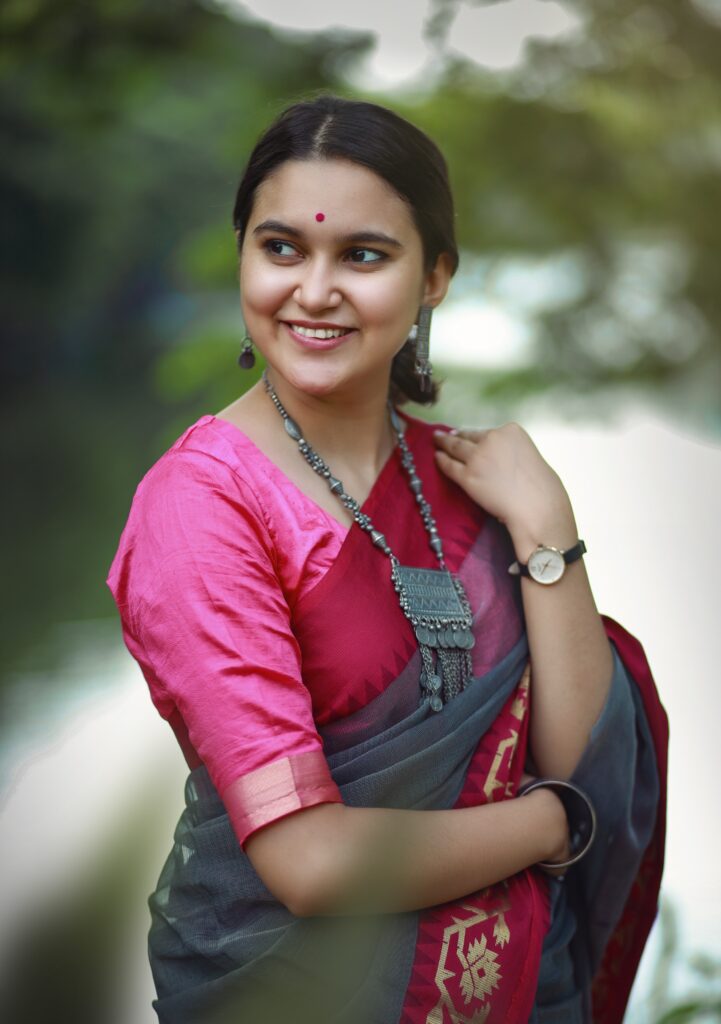Kotpad Patas are traditional handloom sarees that are woven by the tribal weavers of the Kotpad village, located in the Koraput district of Odisha, India. These sarees are known for their unique texture, earthy hues, and the use of natural dyes.
Kotpad Patas are woven using a specific variety of cotton called “Bomkai” or “Sonepuri” cotton, which is locally grown. The cotton is first hand-spun into yarn, and then it is dyed using natural colors that are extracted from plants and minerals. The colors used in Kotpad Patas are predominantly red, black, and white, which are obtained from the roots of the Aal tree, the bark of the Harada tree, and the leaves of the Palash tree, respectively.
The weaving of Kotpad Patas is done on a traditional pit loom, and it involves intricate designs and patterns that are inspired by the tribal culture and mythology of the region. The motifs used in Kotpad Patas include human figures, animals, birds, and natural objects like the sun, moon, and stars.
Kotpad Patas are not just a piece of clothing but also an integral part of the tribal culture and heritage of Odisha. These sarees are popular among women who value traditional handloom fabrics and appreciate the craftsmanship and skill that goes into creating them.
There are several different types of Kotpad Patas sarees that are woven by the tribal weavers of the Kotpad village in Koraput, Odisha. Some of the popular types are:
- Kumbha Sarees: These sarees are named after the Kumbha (pot) motif that is woven on them. The Kumbha motif represents fertility and prosperity and is considered auspicious.
- Tamarai Sarees: Tamarai sarees are named after the Tamarind fruit, which is used to extract a brownish-yellow color for dyeing the cotton yarn. These sarees are known for their unique texture and color.
- Nabarang Sarees: Nabarang sarees are woven using a combination of natural dyes extracted from the roots of the Aal tree and the bark of the Harada tree. These sarees are known for their deep red and black colors.
- Gopali Sarees: Gopali sarees are named after the Gopali (shepherdess) motif that is woven on them. These sarees are typically made in bright colors and are popular among young women.
- Dhawani Sarees: Dhawani sarees are woven using a special technique called “dhawani” that involves creating a resist pattern on the fabric by tying and dyeing it multiple times. This technique creates a unique texture and pattern on the saree.
Each type of Kotpad Pata saree has its own unique features and characteristics, making them highly valued by collectors and enthusiasts of handloom fabrics.
Disclaimer: The content provided on Incredible Sarees’ blog is for informational purposes only. The information presented is based on our knowledge and understanding of sarees as of September 2023, and it may not reflect the latest trends, styles, or industry updates.
The blog posts on Incredible Sarees are intended to provide general information and guidance regarding sarees, including tips on styling, fabric types, draping techniques, and fashion advice. However, it is important to note that fashion trends are constantly evolving, and individual preferences may vary.
While we strive to ensure the accuracy and reliability of the information provided, Incredible Sarees cannot guarantee the completeness, timeliness, or accuracy of the content. Therefore, we advise readers to use their discretion and consult other reputable sources or professionals for specific recommendations and personalized advice.
Incredible Sarees’ blogs may contain external links to third-party websites or resources. These links are provided for convenience and do not imply endorsement or responsibility for the content or services offered on those websites.
The views and opinions expressed in the blog posts are those of the authors and do not necessarily reflect the views of Incredible Sarees as a whole.
Incredible Sarees reserves the right to modify, update, or remove any content on the blog without prior notice. We also reserve the right to change the focus, format, or content of the blog at any time.
By using the information provided on Incredible Sarees’ blog, you acknowledge and agree to the above disclaimer. We encourage readers to engage with us, share their feedback, and contribute to the discussions respectfully.
For any specific concerns or inquiries regarding the content on Incredible Sarees’ blog, please email us at [email protected]


